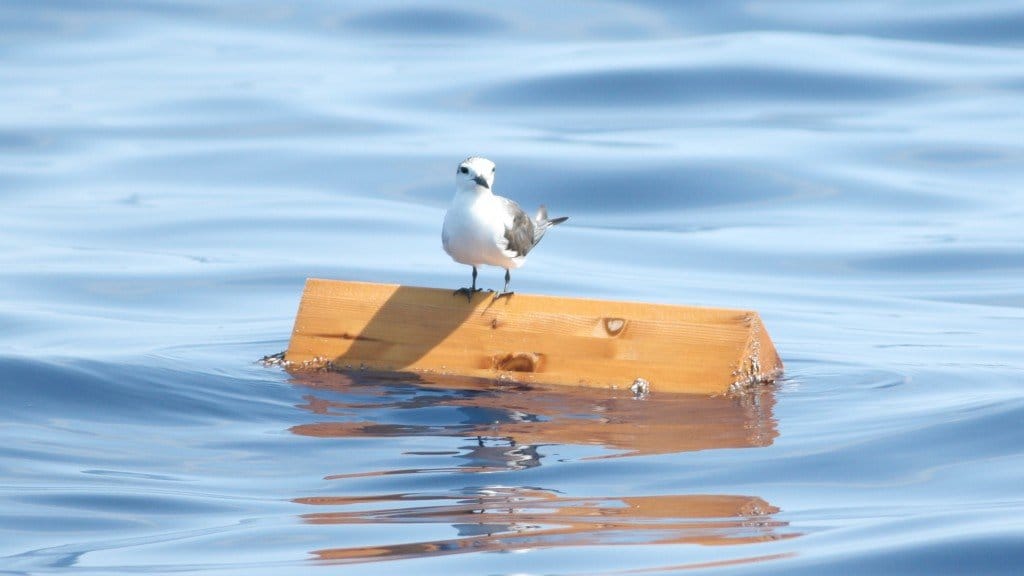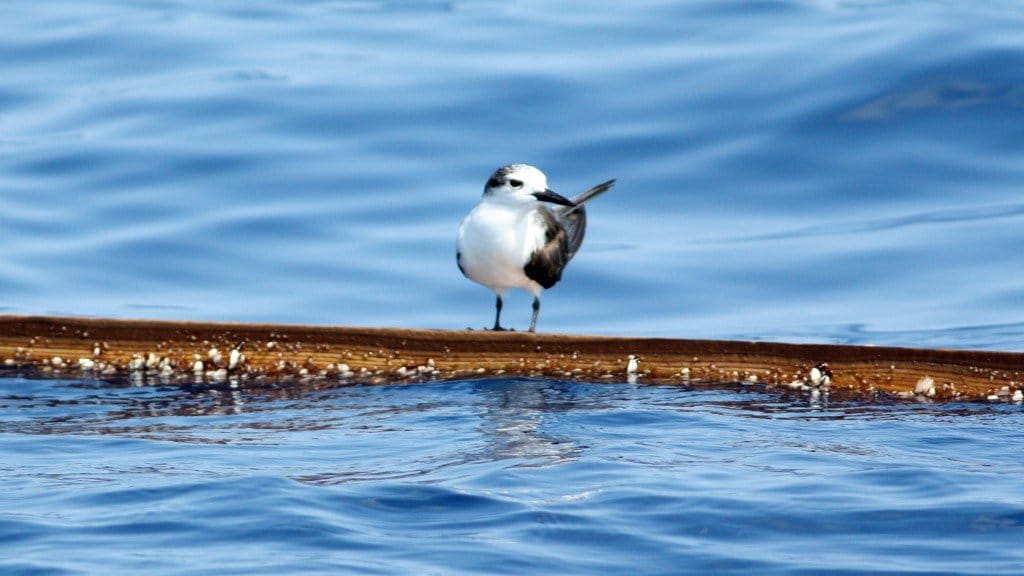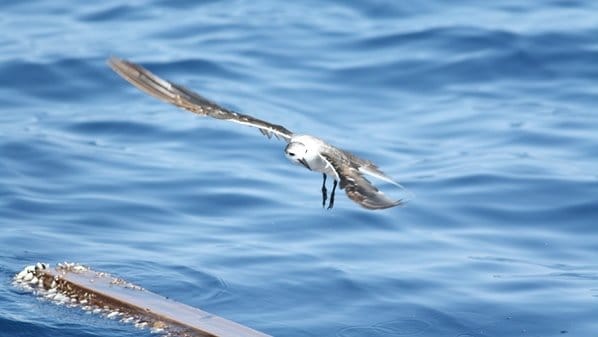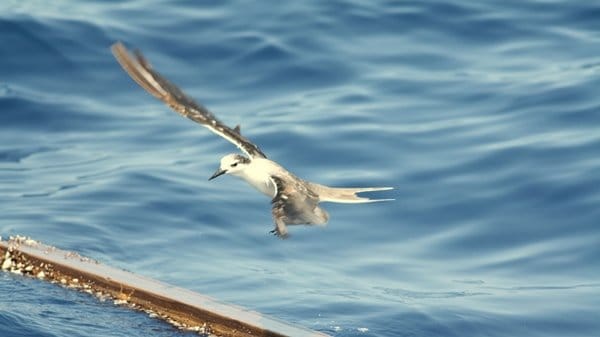From the perspective of the shore, the ocean looks featureless. A pancake flat expanse of blue and green and blue-green (with some green-blue thrown in). From your vantage point at approximately 6 inches above sea level you can see clear to the nearly infinite horizon without squinting. Compare this to birding on land, where desirable warblers and vireos and the like hop around in the very tops of trees obscured by foliage and hidden by knotty limbs and trunks. On the ocean, your view is constrained only by the curvature of the Earth, your limitations aren’t external leaves and branches, but internal. The very strength of your eyes, your ability to hold a pair of binoculars for long periods, your ability to distinguish the subtle difference between distant flying seabirds and eye floaties (very similar, it must be said, especially around hour 10).
But on the sea, bobbing on the surface of that great blue tabletop, you see plenty of… er… blemishes. Off the coast of North Carolina, and indeed anywhere in the southeastern United States, the surface is broken up with vast expanses of sargassum and gulfweed, species of brown algae that floats on the water in great aggregations looking like nothing so much as a perfectly manicured lawn. Beneath these patches young fish and shrimp find refuge, seahorses wrap their prehensile tales around the tangle, and, most obvious to anyone paying attention, mass quantities of garbage coalesce. Gallon jugs that once held detergent. Rusted, empty aerosol cans. Bits of plastic from who knows where. Stuff dropped off of the massive container ships or cruise vessels that ply these waters between New York and the Caribbean or just washed out from rivers on the mainland to collect in what is known among oceanographer types as the North Atlantic Subtropical gyre.
Incidentally, these patches of weed and junk make for a a unique little habitat and are, oddly enough, the best places to look for pelagic terns, specifically the Caribbean nesting Bridled Tern, Onychoprion anaethetus. In fact, the best way to find one of these flashy little Sternids is to find a long rope of Sargassum (and garbage) stretching out as far as you can see, and following that line all the way out with your binoculars. If you’re lucky, you’ll perhaps spot what appears to be a big white dot on the surface of the ocean that on closer approach, if it doesn’t turn out to be an empty bleach bottle, will become a tern sitting on a piece of very manufactured looking refuse. Like, say, a treated piece of lumber.

Pieces of flotsam (another oceanographical term that refers to sea junk), have long been known to be favored perches for these terns. Even before humans came along and started dumping trash into the ocean, pieces of driftwood offered similar purchases. But now that driftwood is salvaged to make tacky furniture the Bridled Terns have to make do with junk. For their part the birds seemed to regard perching on driftwood as passe anyway.
Unless, of course, that driftwood is aged, with lots of barnacles and such. That weather-beaten stuff is really popular right now, I think this sort of wood goes for a pretty penny over at Pottery Barn.

Bridled Terns show a remarkable sense of fidelity to their favored perches. Our boat, a 40+ foot long hulking diesel-spewing fiberglass beast, seemed to cause the bird no distress even as we drifted within only a few meters of it. It would look at us warily, hopping off the perch if we got to close, but returning within seconds. Brian Patteson is an excellent helmsman, and got us just outside its discomfort zone.
While the species has a global distribution, the Bridled Terns that can be found of the coast of the United States nest on various Caribbean islands and on the coast of Mexico. In the late summer, once the young fledge and can more or less fish for themselves, they disperse across the tropical Atlantic from North America all the way to the coast of Africa, riding bits of flotsam much of the way. As such, they’re one of the most common species to encounter in the Gulf Stream from August through October.
These birds though, present in mid-June, are last year’s chicks. The adults are all in tropical climes working on the next generation, but these few left behind are just over one year old and learning the ropes, so to speak. They were in heavy molt, missing multiple flight feathers and showing significant amount of wear on the body. Sea water does a number on feathers just as it does on everything else, slowly corroding the edges and giving birds a blurry around the edges look. Fortunately, new feathers are never more than a year away.

The species we generally consider to be the true pelagics, tubenoses and such, are pretty comfortable on the surface of the water, but I can’t remember ever seeing a tern on the water. I know they do it occasionally, but they’ve always seemed to be above it all, quite literally, and require these patches of junk to rest and relax before coasting down the line of sargassum in search of tiny fish. These perches aren’t much, but that two inches makes all the difference in the world.












Loved this, Nate! Coincidentally, I wrote about my first Bridled Terns–perched on a plank–at birdingnewjersey a few days ago.
Great article Nate! It inspires me to develop a sea-bird tour I will be willing to do.. . hopefully by next fall I will be able to put it together! Thanks!
@Rick- Thanks! I did see that mention. Such great birds.
@Luis- Thanks! Good luck!
Carrie needs to see this posthaste.
I want a Bridled Tern, now!